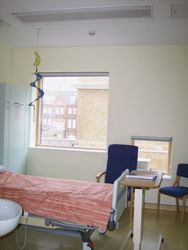Hospitals and other healthcare facilities have specific air conditioning and ventilation requirements.
Key priorities for hospitals and healthcare sites often conflict with one another. A large teaching hospital, for example, requires general-purpose air conditioning equipment, in addition to an array of highly-specialist air handling systems for operating theatres and laboratories etc. This might suggest the need for multiple equipment suppliers.
But the pressure on budgets is such that relationships between the teams building and running hospitals, and their suppliers, need to be completely risk-free. Incompatibility between multiple ventilation systems on the site must be avoided at all costs, and NHS managers need clear accountability for equipment in the event of operational problems.
The key drivers behind design of equipment for the healthcare sector include:
• Better particulate control.
• Ease of cleaning / maintenance.
• Energy efficiency.
• Creation of patient-specific environments.
• Application-specific requirements.
For control of airborne particulates (to reduce cross-contamination in sensitive locations such as operating theatres), the most important developments have involved filter design.
TROX HEPA filter cells, for example, incorporate moisture resistant glass-fibre paper, which is folded into closely spaced shallow pleats. They separate suspended particles or aerosols, toxic dusts, viruses, bacteria etc from the supply or extract air in ventilation systems and are designed for large volume flow rates and long filter life.

DID600 'Clean Beam'
The particularly stringent infection prevention regimes within hospitals have also steered product development. The Royal Alexandra Children's Hospital in Brighton, for example, includes TROX DID 600 'Clean Beams'. These incorporate features for easier maintenance and cleaning, without allowing room contaminants to migrate from and to the ceiling void or supply ductwork.
Completely demountable
The beams are completely demountable, allowing access to each component for quick and easy cleaning by one person. The face of the beam can be hinged down to expose the isolation valve to the coil. The coil can then be disconnected and removed for cleaning.
The area behind the coil, within the body of the beam, can also be cleaned, with both operations carried out while the air is running, i.e. under positive pressure. As chilled beams work on a dry process, there is no moisture on the coil to allow dust and dirt to collect.
An important feature of chilled beam design is that everything is accessible from the face of the beam. This means there is no need to move ceiling tiles, which could lead to dirt being dislodged, which would risk contamination of clean areas. Beams are also designed with smooth surfaces, avoiding joints or sharp edges in which contaminants could lodge.
An alternative is the hingeable coil version of the 'Clean Beam'. Rather than isolating the coil and taking it out, this design allows the far end of the coil to be disconnected and let down on a guide wire (at an angle of about 45 degrees) allowing it to be cleaned without stopping its operation.
Hospitals, with their wide range of patient critical environments, can prove problematic when trying to reduce energy consumption. As with buildings of other types however, there are opportunities to harness the carbon reduction opportunities of variable air volume systems, in preference to constant air volume options.

Royal Alexandra Children's Hospital, Brighton
Active chilled beams or fan coils with EC motors providing heating and cooling via the more energy efficient medium of water can also contribute.
In much of the hospital, the requirement will be primarily for cooling, but in areas such as special care units for premature babies, and geriatric wards, a higher than average temperature is likely to be needed.
If the hospital has laboratory areas on site, then highly-specialist air management systems may be necessary to provide consistency of environmental conditions for processes or experiments, for example for fume cupboards. In addition to technical solutions, the teams involved in the building of new hospitals and the management of existing sites, have a number of commercial requirements.
Most purchasing decisions for this sector - from photocopier paper to MRI scanners - are based on life cycle analysis.
For hvac equipment, this means that there is a greater than average requirement from customers for data on aspects such as long-term energy consumption and costs of maintenance. The arrival in recent years of computer simulation has assisted enormously in providing this level of information.
Two other priorities of customers include the desirability of a single source of supply and (at a time of severe economic pressure) the long-term financial viability of its supply partners.
In conclusion, the breadth and complexity of the technical requirements of hospitals and healthcare sites means that there is an increasing desire for supply relationships, which are as simplified and transparent as possible. This trend is ideally suited to the age-old idea of the 'one-stop shop'.
•
Barry Trewhitt is product manager of TROX UK